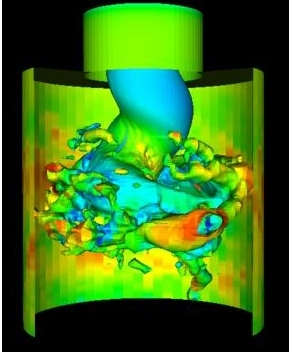This page, 'Unsteady Flow in Draft Tubes', should be part of a frames system at http://www.tfd.chalmers.se/~hani/research/index.html"

Numerical Investigations of Unsteady Flow in Draft Tubes
| Researcher: |
Walter Gyllenram gyllwalt@chalmers.se |
| Supervisor: |
Håkan Nilsson hani@chalmers.se |
| Examiner: |
Lars Davidsson lada@chalmers.se |
| Cooperation: |
UNICC/C3SE, Chalmers NTNU Trondheim VATECH |
| Sponsors: |
The Swedish National Energy Admininstration GE Energy (Sweden) AB The Swedish Electrical Utilities R&D Company |
| Publications: | [6] |
| Start of project: | June 2003 |
BACKGROUND Approximately 50% of the electrical power produced in Sweden is generated by water turbines. Consequently, even a small improvement of their hydrodynamic design can contribute a great deal to the supply of energy. An overview of a hydraulic power plant is shown in here. The available (potential) energy is proportional to the static head, and the potential energy is converted to kinetic energy by letting gravity work on the water. The kinetic energy is in turn converted to electrical energy by a runner that is connected to a generator. Downstream of the runner in hydraulic power plants of the Francis or Kaplan type , the flow exits the water turbine through a draft tube. The purpose of the draft tube is to reduce the exit velocity with a minimum loss of energy. This will induce a relatively lower static pressure in the region just downstream of the runner. Hence, the pressure difference over the runner and thereby also the output power will increase. The efficiency of the draft tube is very important for a water turbine working at low head and it is determined by how well the flow responds to the geometry. The design of many draft tubes in use today is far from optimal and, wh en old hydro-power plants are refurbished, possibilities exist for modifying the draft tubes. A swirling flow is created in the wicket gate just upstream of the runner, see Fig. 2 (left). The runner rotates in the same direction as the flow, and the runner blades will counteract and neutralise the tangential velocity component if the turbine is working at its design point. Usually a small part of swirl is allowed to enter the draft tube in order to stabilise the flow and to prevent flow separation. However, at part load, a strongly swirling flow will exit the runner in the form of a large vortex. Because of the strong adverse pressure gradient in the draft tube, this vortex may break down into a precessing asymmetric shape and give rise to an oscillating pressure field. The pressure fluctuations in the draft tubes of Francis turbines can cause vibrations of a magnitude that endangers the supporting structure of the machine. While the pressure fluctuations in Kaplan turbines are usually not large enough to cause structural damage, the draft tube of a Kaplan turbine is very sensitive to flow separation. Flow separation can be triggered by pressure fluctuations and have a serious impact on the efficiency of the power plant. To improve the hydrodynamical design of the turbine it is necessary to be able to accurately predict these features of the flow. The flow in draft tubes is complicated. It is a swirling, unsteady, partly separated flow at curved surfaces, flowing against an opposing pressure gradient. These features are all difficult to predict numerically. In this thesis, the flow in simplified draft tube geometries is considered in order to isolate and study the most important physics of real draft tube flow. PUBLICATIONS If you download a document or have any comments concerning the work or the web-page, please send me an e-mail or let me know by filling up this form:
- click
BACK TO TOP |
|
This page, "Unsteady Flow in Draft Tubes", should be part of a frames system at www.tfd.chalmers.se/~hani/research/index.html |